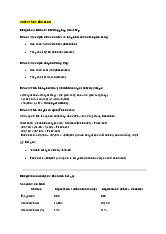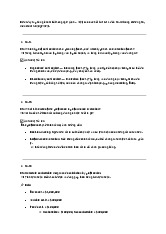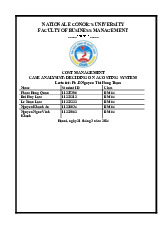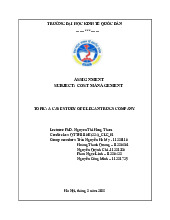


















Preview text:
lOMoAR cPSD| 58511332
Eggers Company needs 20,000 units of a part to use in producing one of
its products each year. If Eggers buys the part from McMillan Company
for $90 per unit instead of making it, Eggers will not use the released
facilities in another manufacturing activity. Forty percent of the fixed
overhead will continue irrespective of CEO Donald Mickey’s decision.
The cost and volume data are given below: Data: -
Volume of parts (units) required: 20,000 per year -
Purchase price per unit from outside supplier: $90.00 -
% of fixed overhead that is unavoidable: 40% Full
Manufacturing Cost per Unit Produced: - Direct materials: $35.00 - Direct labor: $16.00 - Variable overhead: $24.00 - Fixed overhead: $20.00 Total: $95.00 Requirements
1. Determine which alternative is more attractive to Eggers and by what amount.
2. What strategic factors might bear upon the ultimate decision? If Eggers MAKES the part: Relevant costs: Direct materials: $35 Direct labor: $16 Variable overhead: $24
Avoidable fixed overhead: 60% × $20 = $12
Total relevant cost per unit: $35 + $16 + $24 + $12 = $87 If Eggers BUYS the part: Relevant cost per unit: $90
B. Total Relevant Cost for 20,000 Units lOMoAR cPSD| 58511332
Alternative Relevant Cost per Unit Total Relevant Cost (20,000 units) Make$87 $1,740,000 Buy $90 $1,800,000
Difference: $1,800,000 (Buy) – $1,740,000 (Make) = $60,000
Conclusion: Making the part internally saves Eggers $60,000 per year compared to buying.
2. Strategic Factors to Consider
When making the final decision, Eggers should also consider:
- Quality control: Will the supplier meet the same quality standards as internal production?
- Reliability of supply: Is the supplier dependable regarding delivery times and quantities?
- Confidentiality and proprietary knowledge: Will outsourcing risk
disclosing proprietary processes or designs?
- Long-term flexibility: Will Eggers be able to restart production
easily if needed in the future?
- Employee impact: Will stopping internal production negatively
affect employee morale or result in layoffs?
- Supplier relationship: Could dependency on a single supplier create risks?
- No opportunity cost: Since the facilities cannot be used for other
purposes, there is no opportunity cost benefit from buying. Summary
- Eggers should continue to make the part internally, as it is $60,000 cheaper per year than buying.
- Strategic factors such as quality, supply reliability, and long-term
flexibility should also be weighed before making a final decision.
Cantel Company manufactures cleaning compounds for both
commercial and household customers. Some of these products are
produced through a joint manufacturing process. For example, GR37 is
a coarse cleaning powder intended for commercial sale, which costs
$1.60 per pound to produce and sells for $2.00 per pound. Part of the
annual production of GR37 can be further processed in a separate lOMoAR cPSD| 58511332
department, where it is combined with other ingredients to create SilPol,
a silver polish that sells for $4.00 per unit.
Producing SilPol requires ¼ pound of GR37 per unit. Additional
processing costs are $2.50 per unit of SilPol, and variable selling costs
for SilPol average $0.30 per unit. If SilPol production is discontinued,
$5,600 of processing department costs would be avoided. At this time,
Cantel has unlimited demand for both products, but can only produce a limited amount of GR37.
Assume the cost data for GR37 is based on a maximum output of 5,000
pounds, which is the company's current production limit. What is the
expected operating income (rounded to the nearest dollar) under each of the following scenarios:
(a) All available capacity is used to produce GR37 only (no SilPol). (b)
4,000 units of SilPol are produced, with the remaining capacity used for GR37. (c)
8,000 units of SilPol are produced, with the remaining capacity used for GR37. lOMoAR cPSD| 58511332
(d) 10,000 units of SilPol are produced, with the remaining capacity usedfor GR37. Answer:
7,000 units of SilPol must be sold to justify further processing of GR37
2. Expected Operating Income Under Different Scenarios Assumptions: lOMoAR cPSD| 58511332 lOMoAR cPSD| 58511332 lOMoAR cPSD| 58511332 lOMoAR cPSD| 58511332 lOMoAR cPSD| 58511332 lOMoAR cPSD| 58511332 lOMoAR cPSD| 58511332
Strategic Considerations in Make-vs.-Buy Decisions
When deciding whether to produce a product internally or purchase it
from an external supplier, companies must weigh a range of strategic
factors beyond just cost. Key considerations include:
- Core Competencies: Assess whether manufacturing the product
internally leverages the company’s core strengths. If the activity is
not a core competency, outsourcing may allow the company to
focus resources on areas that provide greater competitive advantage.
- Total Cost Analysis: Look beyond direct costs to include indirect
and hidden costs such as logistics, supplier management, quality lOMoAR cPSD| 58511332
control, and potential disruptions. A thorough total cost of
ownership (TCO) analysis is essential.
- Quality and Control: In-house production offers greater control
over product quality, intellectual property, and compliance with
regulations. Outsourcing may risk quality issues or loss of
proprietary knowledge, but can also provide access to specialized
expertise and advanced technology.
- Flexibility and Scalability: Consider the ability to scale
production up or down efficiently. External suppliers may offer
greater flexibility and faster response to market changes, while
inhouse production may be less agile but more consistent.
- Supply Chain Risk and Resilience: Evaluate risks such as
supply chain disruptions, geopolitical factors, and reliability of
suppliers. In-house production can reduce dependence on
external parties, while outsourcing may expose the company to more external risks.
- Capacity and Resource Utilization: Assess whether the
company has the available capacity and resources to produce
internally without disrupting other operations. Outsourcing can free
up internal resources for other strategic initiatives.
- Strategic Alignment: Ensure the decision aligns with the
company’s long-term strategic goals, including vertical integration,
market positioning, and innovation objectives.
- Regulatory and Compliance Issues: Ensure compliance with
industry standards and regulations, which may be easier to
manage internally in some cases. lOMoAR cPSD| 58511332 lOMoAR cPSD| 58511332 lOMoAR cPSD| 58511332 lOMoAR cPSD| 58511332 lOMoAR cPSD| 58511332 lOMoAR cPSD| 58511332 lOMoAR cPSD| 58511332




